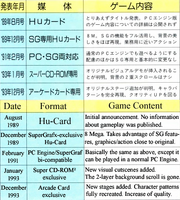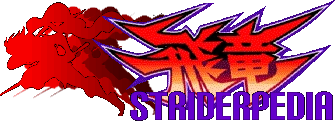
The PC Engine port of Strider is infamous for its protracted development, which extended over four years from its initial announcement in 1989 to its final release in 1994, and saw the game change its format at least 4 times before winding up as an Arcade CD-ROM² release[1]. Its cancelled initial conversion for NEC's SuperGrafx is also well-known for the number of rumors surrounding it and the nigh-mythical status of its existence in prototype form.
Development History[]

Timeline of the port's format changes as documented by PC Engine Fan
The first official announcement of NEC Avenue porting Strider surfaced around August 1989, stating it was a PC Engine Hu-Card convertion[1]. No further information was given until December, when its upgrade to a SuperGrafx exclusive was confirmed[1][2][3]. Further coverage during 1990 by PC Engine Fan stated it was developed on a 8-mega Hu-Card and claimed it'd reproduce graphics, animations and gameplay "almost as close" as those of the Arcade[1][4]. At the beginning of 1991, however, they reported its downgrade to a bi-compatible SuperGrafx/PC Engine title[1][5]. That same month, EGM claimed in their letters column that NEC's port was playable, and furthermore, that they had played it during a trip to Japan the previous September[6]. However, the port was still in development in late 1991, with PC Engine Fan claiming it was still only twenty percent complete[7]. EGM commented on the delays in late 1992, revealing that the SuperGrafx port had been "downgraded" to the Super CD-ROM² system while still remaining "greatly enhanced".[8]
In Japan, news of Strider would not surface until January 1993, when the port's third change in format was reported now being developed exclusively on the Super CD-ROM², together with the inclusion of fully-animated original cutscenes replacing the Arcade game's multilingual scenes[1]. Then the following December a new report on Strider published the first actual in-game screenshots[9] and announced the final format change, now becoming an Arcade Card exclusive in order to increase the game's quality and animations[1]. The report also announced two brand-new, exclusive stages were to be included[1], although the final product only features one (Oil Fields). Data buried within the game's coding confirms the existence of a second unfinished stage, however.
By October 1993, Strider was stated to be 60% complete and have a planned release date in March 1994[1]. But the game suffered even more delays afterwards, with Dengeki PC Engine magazine listing a new date in each "New Soft Schedule" section from their May to August issues[10]. Executive producer Toshio Tabeta twice adressed the many delays his games suffered and eventually shaved his head on camera over them.[11]
Around the same time Tabeta was also producer of another PC Engine game titled Monster Maker: Yami no Ryuukishi, a RPG based on a very popular card game in Japan. Originally planned for release in 1992, in mid 1993 he promised the fanbase through the magazine Dengeki PC Engine that he'd shave his head if he missed its November 26, 1993 release date[12]. When the magazine announced the game's delay in its December issue, Tabeta kept his word and provided pictures of his shaved head[9][12]. He would later repeat and fulfill this same promise in 2000 when another game under his charge (Sentimental Graffiti 2) ran into similar delays.[13]
In July of 1994, in an interview with gaming magazine Edge, NEC Avenue's Multimedia Division manager Kimihisa Usui claimed that both the SuperGrafx's low sales due to its high price point and publishers' lack of support for the system caused NEC to produce a standard PC Engine port instead. At a later date, they decided to use the Arcade Card feature to improve the conversion[2]. Finally, this port was released as a regular CD-ROM² for the Arcade Card in September 1994, a full four years after the SuperGrafx HuCard's announcement in PC Engine Fan.[14]
Supergrafx Rumors[]
As its development was poorly documented in the West, many rumors arose about NEC's "lost" SuperGrafx port. These rumors encompassed everything from the existence of rare, working betas with superior graphics to suicidal programmers.
Existence of Playable Alphas[]
The demotion from SuperGrafx to Arcade Card was virtually unknown in the West. Without this knowledge, many have searched in vain for the alphas of NEC's Strider port. TurboGrafx enthusiasts have frequently insisted that a specific number of prototypes exist. These rumors can be traced to a 1997 post on the Turbo List listing five EPROMs in circulation, all but one of which were accounted for[15]. Another fan, Daniel Riley, claimed there were four copies of a three-level playable alpha[16]. Others have scoffed at the notion of prototypes, citing the lack of hard evidence as proof that they never existed.[17]

One of the screenshots used by PC Engine Fan
A number of screenshots accompanying the articles featured small differences when compared to the Arcade game, such as Hiryu's health bar displaying a different, red gradient color. These differences fueled rumors of the existence of a prototype, but years later they were confirmed to come from a very early prototype of the Arcade, and actual in-game screenshots of NEC Avenue's port didn't surface in Japan until December 1993.[9]
In the end, the argument is moot. The CD-ROM² port is a downgraded version of the SuperGrafx port and reuses its assets, as gaming magazines and gaming journalists in both the East[4][5][7] and West[6][8][11] have attested.
Superior Graphics[]
It is frequently thought that the alphas would have been "better than the arcade". This would have been objectively impossible. CPS-1 specifications far outweighed the SuperGrafx' capabilities. However, it's important not to take this claim too literally. Gaming magazines of the time often used the phrase "arcade perfect" to denote a superior port that surpassed expectations for a given system, and fans of that game system may simply be reusing journalistic hyperbole. Thus, it's uncertain how this port would have looked on a SuperGrafx. What is certain is that the released version does not live up to the praise used to describe the alphas.
Suicide Rumor[]
It has also been repeated ad nauseam that someone killed themselves during the development of NEC's Strider port. This rumor owes its origin to a blurb contained within Videogames.com's 1997 article, "The History of Street Fighter", which claimed a "former Capcom employee" under "heavy pressure" to surpass the Genesis port "cracked under the stress and wound up in a mental hospital", whereupon Hiryu was made to toss a teddy bear during his appearance in Ken Masters' Street Fighter Zero 2 stage, as "a reference to the employee's intractable condition"[18]. Gaming site Ralph Space repeated this "completely unsubstantiated rumor", embellishing it with an addition from "very trustworthy sources" who said "one of the programmers took his own life in a bout of depression allegedly caused by the poor quality of the game"[19]. From there it spread like wildfire, to Strider-Otaku and beyond.[20]
The above remains unconfirmed. No one was ever named, and the lost Capcom programmer was not any of the following Strider creators:
- Kouichi Yotsui, designer of the coin-op. He neither cracked nor killed himself. When asked about this rumor, he said "only an amazingly small part" of him thinks the rumor is true, and that the teddy bear's appearance was probably just the Street Fighter Zero 2 staff "goofing off".[21]
- Masahiko Kurokawa, designer of the Famicom version. He later worked on Mega Man 3 and wrote the Tomba! series.
- Tatsumi Wada, illustrator of the 1988 Moto Kikaku manga. He illustrated several more manga series and was alive at least until 1997.
- Toshio Tabeta, the NEC port's executive producer. Although shaving his head for the magazines probably inspired the story of the programmer-gone-mad[11], he is very much alive and well. He is currently President of Japanese game developer Prototype.[22]
- The graphic designer who liked teddy bears. There is a teddy bear power-up hidden in stage three of the coin-op. The graphic artist who put it there later married Keiji Inafune.[21]
References[]
- ↑ 1.0 1.1 1.2 1.3 1.4 1.5 1.6 1.7 1.8 Staff (December 1993). "Arcade Card Big Feature: Strider Hiryu" (Japanese). PC Engine Fan. Pg. 20-21
- ↑ 2.0 2.1 Staff (July 1994). "NEC Avenue". Edge (10). Pg. 38.
- ↑ Staff (December 1989). "Development Confirmed! Strider Hiryu" (Japanese). Gekkan PC Engine (15). Pg. 15
- ↑ 4.0 4.1 (September 1990). "Strider Hiryu" (in Japanese). PC Engine Fan (Tokyo: Tokuma Shoten). Retrieved December 13, 2010.
- ↑ 5.0 5.1 (January 1991). "Are SG Games Being Withdrawn?" (in Japanese). PC Engine Fan (Tokyo: Tokuma Shoten). Retrieved December 13, 2010.
- ↑ 6.0 6.1 (January 1991). "A Complaint!???" (in English). Electronic Gaming Monthly 18 (Sendai Publications). Retrieved December 13, 2010.
- ↑ 7.0 7.1 (September 1991). "Strider Hiryu" (in Japanese). PC Engine Fan (Tokyo: Tokuma Shoten). Retrieved December 13, 2010.
- ↑ 8.0 8.1 Aki, Terry (October 1991). "International Outlook" (in English). Electronic Gaming Monthly 39 (Sendai Publications).
- ↑ 9.0 9.1 9.2 Staff (December 1993). "NEC Avenue Times" (Japanese). Dengeki PC Engine (11). Pg. 75
- ↑ Dengeki PC Engine Magazine. TurboPlay Magazine Archive. Accessed April 30, 2016
- ↑ 11.0 11.1 11.2 Gifford, Kevin (July 14, 2009)."(I ♥ The PC Engine) Fantasy Zone" (in English). Magweasel. Retrieved December 21, 2010.
- ↑ 12.0 12.1 PCEngineCLUB (March 17, 2017). "PCEngineCLUB's twitter" (Japanese). Accessed November 28, 2019.
- ↑ Staff (March 24, 2000). "Catch the moment of Sentimental Grafitti 2 General Producer Toshio Tabeta's shaving!" (Japanese). Dengeki Dreamcast (31). Pg. 10
- ↑ Dice Creative, Ltd. Strider Hiryu (in Japanese). (NEC Avenue). PC Engine CD-ROM². Level/area: End credits. (September 22, 1994).
- ↑ Lyon, Mike (05 Jan 1997). "SG Strider: The Scoop". Turbo List Digest. Retrieved December 27, 2010.
- ↑ Riley, Daniel. "Strider". SuperGrafx Extreme. Waybacked. Retrieved December 27, 2010.
- ↑ Wright, Lawrence. "101 PC Engine Secrets (* Or Maybe Less)". NFG Games. Retrieved December 27, 2010.
- ↑ "The History of Street Fighter: The Games: Street Fighter Alpha 2". Videogames.com. Waybacked. Retrieved December 29, 2010.
- ↑ Ralph. "Ralph's Mysterious Video Games Page: That Guy Who Killed Himself Over Strider". RalphSpace. Waybacked. Retrieved December 29, 2010.
- ↑ Varley, Michael. "S T R I D E R - O T A K U --HISTORY--". Strider-Otaku. Retrieved December 29, 2010.
- ↑ 21.0 21.1 Scion; Dire 51 (24 April 2010). "Interview with Kouichi "Isuke" Yotsui". LSCM 4.0. Translated by Gaijin Punch. Retrieved October 24, 2010.
- ↑ "About Us" (in Japanese). Prototype, Inc. Retrieved December 31, 2010.
| The Development of Strider | |
|---|---|
| Development sub-pages | Strider (CPS-1) • Strider (NES) • Strider (Mega Drive) • Strider II Strider (PC Engine) • Strider 2 • Strider (2014) |
| Prerelease content | Strider (CPS-1) • Strider (NES) • Strider (Mega Drive) • Strider 2 • Strider (2014) |
| Unused content | Strider (CPS-1) • Strider (PC Engine) • Strider (NES) • Strider 2 • Strider (2014) Unused enemies • Unused stages |
| Cancelled games | Strider Hiryu (Famicom prototype) • Untitled game projects • Untitled GRiN Project |
| Related | Cannon Dancer (Prerelease content • Unused content) Isuke's scenario draft |
